The Great Wall of China is the most famous city wall in the world, and therefore not only in China. Among the seven wonders of the modern world , the Great Wall of China is among the most famous architectural works, as well as a symbol and among the main attractions in China. A defensive wall with an ancient and long history, which winds through the landscape and the imperial dynasties , until today. So let’s discover its history , its characteristics and the best way to visit it during your trip to China in our guide!
Great Wall of China in Brief, Useful Info
| Address | Huairou, Cina, 101406 |
|---|---|
| Number | +86 10 6162 6022 |
| How to get | Accessible from Qinghai province or Beijing From Beijing : Badaling, by bus no. 919 from Deshengmen or via train, from Beijing North Station. Mutianyu, with bus no. 867 from Dongzhimen Station. |
| Opening time | Badaling : 6am to 7pm in summer and 7am to 6pm in winter Mutianyu : 7am to 6.30pm in summer and 7.30am to 5.30pm in winter |
| Price | Badaling : ¥45 (1 April – 31 October) and ¥40 (1 November – 31 March) Mutianyu :: ¥45 Jīnshānling : ¥65 (mid-March – mid-November) and ¥55 (mid-November – mid-March) Simatai : ¥ 40 Jiànkòu : free *Cable car excluded |
| Advise | Visit the Wall from Beijing by choosing the Mutianyu section. |
Where is the Great Wall of China located
Extended non-continuously for thousands of kilometers to the extreme north of China, from the North Korean border, reaching the desert line. The westernmost end is located in Gansu , the Jiayuguan Pass . It then passes through the mountain province of Jinshan , arriving at Shanhai Pass , meeting the sea in the Bohai Gulf . Considering its branches, the Great Wall of China is approximately 21,196.18 km long , 5 to 8 m high, with a width of approximately 6.5 m. Furthermore, it is not possible to follow it continuously, as it is currently divided into 32 sections .
It passes through 9 provinces in total : Gansu, Ningxia, Shaanxi, Shanxi, Inner Mongolia, Beijing, Tianjin, Hebei and Liaoning. It is about 90 km from Beijing . So let’s find out what the Great Wall of China is, its history and its characteristics in our guide, to visit it as best as possible during our trip to China.
Click the button and find all search platforms and book your next trip yourself.
Read also: Mayan ruins Chichen Itza in Yucatan Mexico
History of the Great Wall of China
The construction
As early as the Spring and Autumn Period , from the 8th and 5th centuries BC, the Chinese people knew the techniques for building walls. During this period of Chinese history, and the period after the Warring States , the states of Wei, Qin, Zhao, Qi, Yan and Zhongshan increased their fortifications, with the aim of defending their borders and better resisting attacks. This wall, in fact, had to resist weapons, making it more resistant using gravel and earth. In 221 BC , when Qin Shi Huang unified China by prevailing over opposing states, the Qin dynasty was born .
A centralized dominion is thus imposed , avoiding the reappearance of feudal kingdoms. To better defend the territory from the northern Xiongnu, he orders new walls to be built, joining the already existing fortifications located on the northern borders of the Empire. However, the transport of materials was complicated over such a long territory. For this reason the walls feature various materials, as the builders decided to always choose resources found on site. Mountain stones for mountain areas and rammed earth in the plains.
The expansion of the Wall
To date, no documents have been found that can tell us how large the Great Wall of China was at the time of its construction, and most of the older walls have eroded over the centuries . Furthermore, it is estimated that one million workers perished during its construction under the Qin Dynasty. Later, other dynasties, such as the Sui and Han , also repaired and expanded some sections of the Wall, thus continuing to defend the empire from invasions to the north. Other walls were added between the 10th and 13th centuries by the Liao, Jin, and Yuan dynasties , especially those found today in Outer and Inner Mongolia .
Construction during the Ming Dynasty
In the 14th century , the construction of the Great Wall of China was resumed by the Ming Dynasty , following the defeat against the Oirats during the Battle of Tumu Fortress . The conflict was wearing down the empire, and they were unable to achieve a definitive victory over the tribes of Mongolia and Manchuria . Respecting the Mongols’ control of the Ordos Desert , they then began construction of new walls in the northern border, following the desert. Unlike the construction of the previous Chinese Wall, that of the Ming used stones and bricks and not earth, making it more resistant.
They also built around 25,000 watchtowers along the wall , but the Mongol raids continued. It was therefore necessary to further fortify the wall areas near Beijing . From Shanhaiguan to Changping the general Qi Jiguang added 1,200 towers to keep watch for raiders, and from 1440 to 1460 the Ming also built the Liaodong Wall , protecting the agricultural province. In 1644 , the Manchus crossed the wall to conquer China.
The beginning of the Qing dynasty and the end of construction
In Shanhaiguan , the Ming general Wu Sangui opened the gates, allying himself with the Manchus, hoping to exploit them to expel the rebels from Beijing, but they took the city, after defeating the Shun dynasty and after the Ming resistance, thus starting the dynasty Qing and taking control of the entire country. Under their dynasty, China’s borders reached beyond the wall, also taking Mongolia into the empire and stopping the construction of the wall.
The Great Wall of China throughout history
The Great Wall of China has passed through time and eras, reaching today and becoming one of the Seven Wonders of the Modern World . Furthermore, it has only recently been recognized as a valuable architectural work by the Chinese people, as it was previously considered the expensive work of a tyrant . When in 1800 travelers from the West also began to visit it, obviously becoming fascinated by it, the Great Wall in China became a symbol of the country. Furthermore, during the Cultural Revolution it was completely abandoned, recently undergoing major restoration works to enhance it again. In the past, the wall was also infamous as the longest cemetery in the world , with its construction estimated to have killed one million workers.
Furthermore, the economic commitment for its construction was enormous and internal revolts were frequent due to the difficulties that made the kingdoms weaker, leading to the end of families and interrupting the construction of the wall several times. Therefore, not only does it have a past on the Silk Road which increased trade routes and improved defence, but there are also dark sides in its history which it is important not to omit. Today, the Great Wall is among the most important architectural works in the world, which has inspired international writers and directors, as well as being a popular destination for travelers from all over the world.
The Great Wall of China, Map and Features
Before setting out to discover this place, we advise you to look at the Great Wall of China map, to better understand its position and its sections.
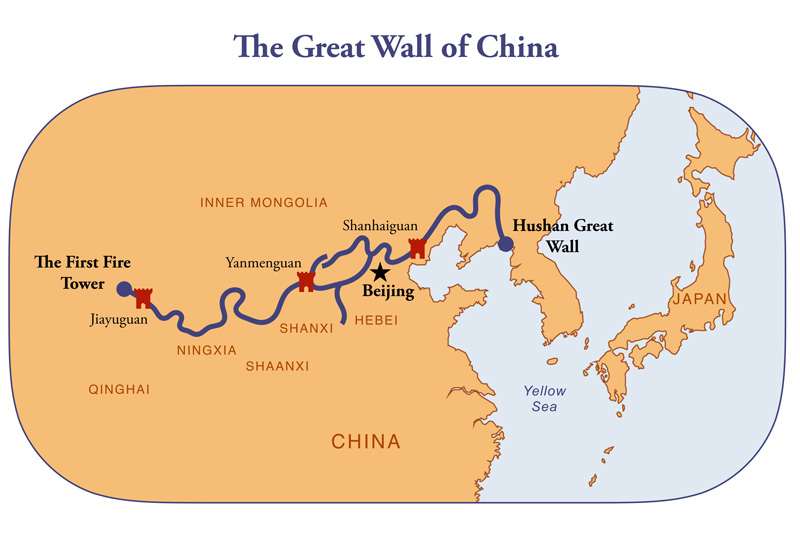
The course of the Great Wall
As seen in the Great Wall of China map, it is mainly located in northern China , an area where barbarian incursions were most frequent. However, sections can also be found in the south of the country, referred to as the Great Wall of the South . The structure, even if defined by everyone unanimously, is not easy to define overall today. The easiest area to trace is certainly the one built by the Ming dynasty . Its western terminus of the Ming Wall is in Gansu Province : Jiayu Pass . From here the wall, discontinuously, crosses the Gansu Corridor and in the deserts of Ningxia , passes near the Yellow River , in Yinchuan .
In Shanxi province , in the city of Xinzhou , at the Piantou Pass, the Great Wall of China splits into two , becoming the Outer and Inner Great Walls , which run along the border with Mongolia and southeast, towards the Piantou Pass. Then the Inner Wall joins the Outer Wall in Yanqing County , Sihaiye . Here we find the most visited sections of the wall near Beijing , as well as being the best maintained. At the Bohai Gulf, we find the Shanai Pass , considered the end of its course also called The First Passage Under the Sky . The area touching the sea is also called Old Dragon’s Head .
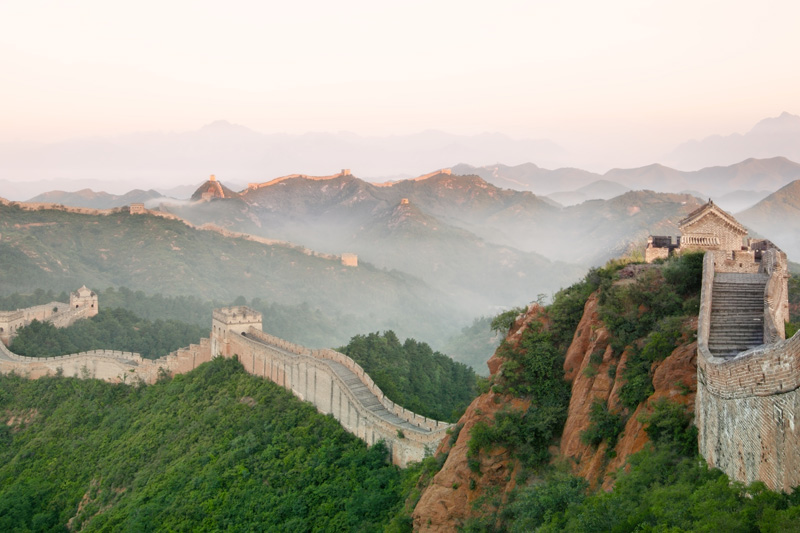
The main sections
1. Mutianyu
The most popular area for travelers is the Mutianyu section, as it is also the easiest to navigate and also suitable for families. For this reason, however, it can also be more crowded. It is located 73 km from Beijing and is characterized by turrets and small fortresses, a unique example of Chinese architecture , such as the battlements on the sides of the wall. To reach it there is a cable car.
2. Jinshanling
Loved by hikers and passable up to the Simatai section , the Jinshanling wall is characterized by being only half restored . In this way it will be possible to observe half of the original wall. Furthermore, it is considered one of the most beautiful sections of the wall and therefore loved by photographers. It is located 154 km from Beijing and there is a cable car to reach it. Also called the Golden Mountain Range , this is one of the most scenic spots, renovated in the 16th century AD
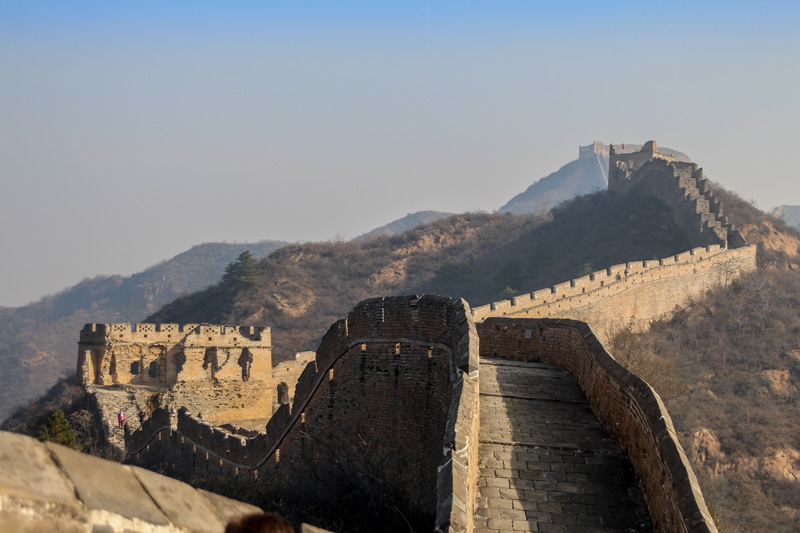
3. Jiankou
For the truly adventurous, 100 km from Beijing we find the section of the Jiankou Wall . Characterized by slopes and surrounded by a wild landscape, it is the most challenging and dangerous area . Some parts are really difficult, winding through the mountains in a W shape .
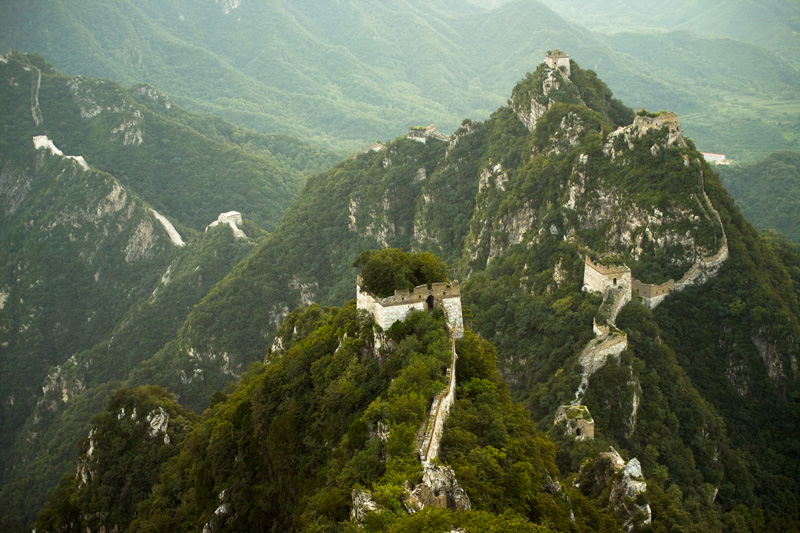
4. Simatai
This section 120 km from Beijing is truly special, as well as being a UNESCO World Heritage Site since 1987 . Very steep and a source of inspiration for photographers , it incorporates all the characteristics of the other areas of the wall. to reach it there is a cable car, buses from the village of Simatai, boats in the surrounding area and it is possible to go zip-lining .
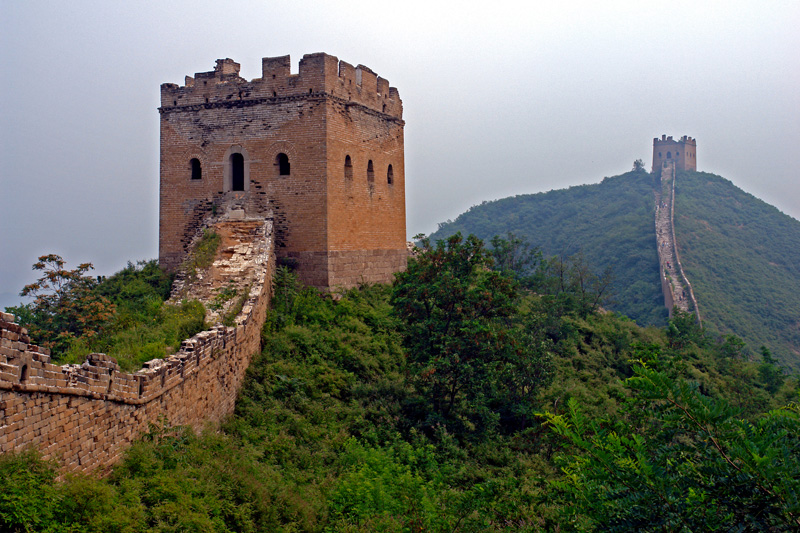
5. Huanghuacheng
Joining the waters of the lake in a very distinctive way , the Huanghuacheng section is located 75 km from Beijing and many parts of it are submerged by the lake or surrounded by chestnut trees dating back to the Ming period. Furthermore, it is possible to camp here from May to September and there are boats in the surrounding area.
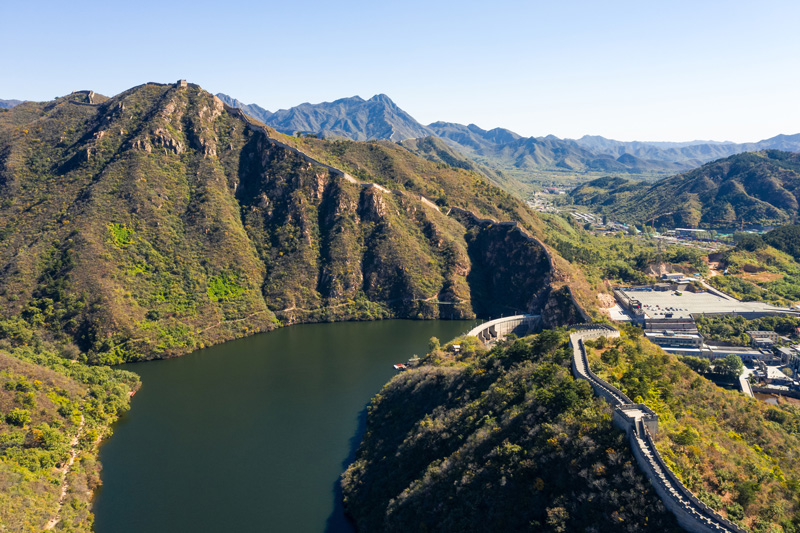
6. Juyongguan
To conquer the territories of ancient China, Genghis Khan passed through the Juyongguan section. 60 km from Beijing, this is among the most easily accessible sections and easy to access for everyone.
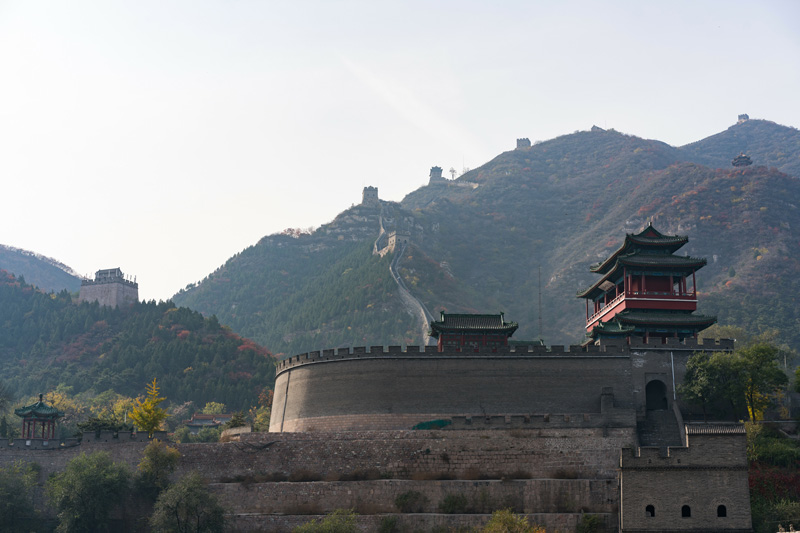
7. Gubeikou
In China, 146 km from Beijing, the Gubeikou section is perfectly intact and wild . An important step in the past, being in the Mongolian area to the north, home to numerous battles, over 130 . There is no type of service here and it is loved by the most adventurous hikers .
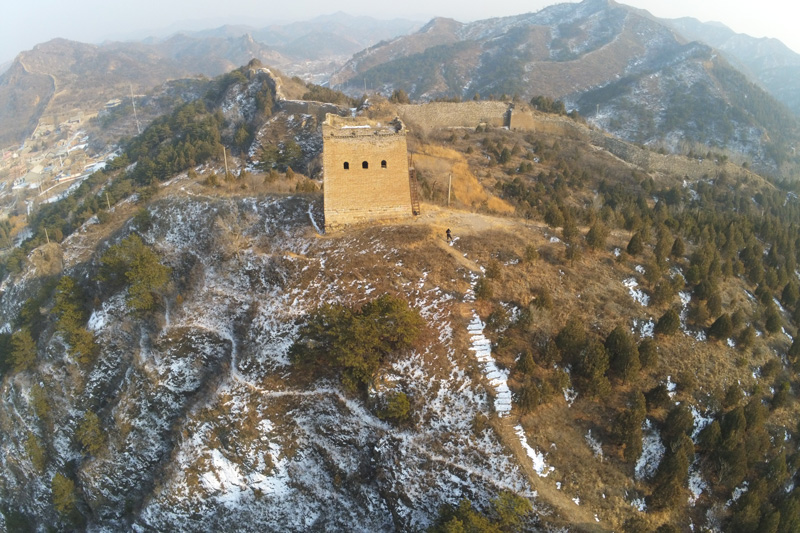
8. Huangyaguan
Every year in May in China, a famous marathon is held in the Huangyaguan section . Located in Ji Country , Tianjin, it takes about 3 hours by car to reach it from Beijing. Furthermore, there are tourist buses here that take you to the top of the mountain.
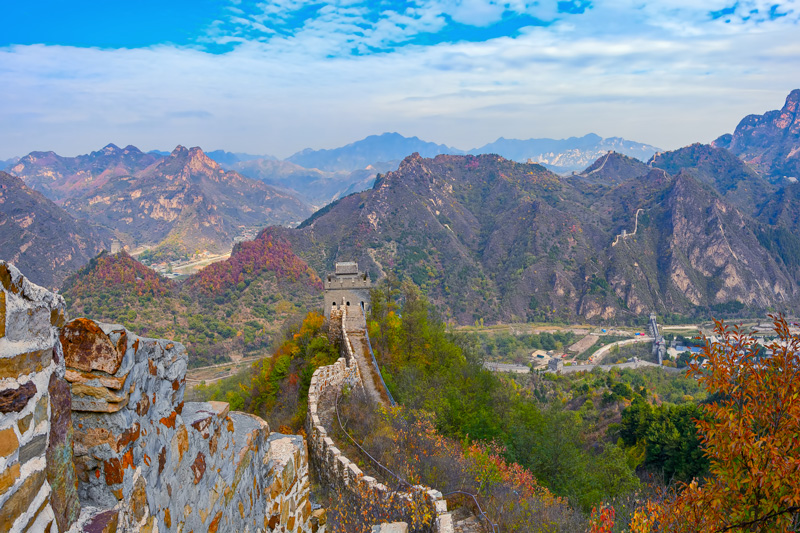
9. Change
The area of the Great Wall of China most loved by Chinese tourists, Badaling is located 72 km from Beijing and is always a crowded area. Furthermore, here there is a cinema , the Great Wall Museum and it is easily accessible by anyone, even by cable car.
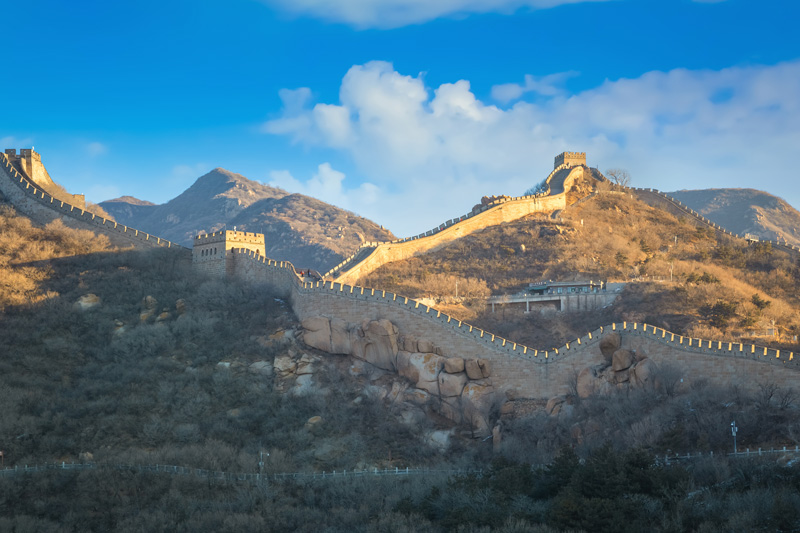
10. Passo Shanhai
Finally, we come to see the great wall in China, where, after crossing mountains, plateaus and deserts, it meets the sea . In the past this was a strategic point , important to face the invasions of Manchuria. It is located more than 3 hours from Beijing, in the Hebei region, in Qinhuangdao and was built during the Ming Dynasty.
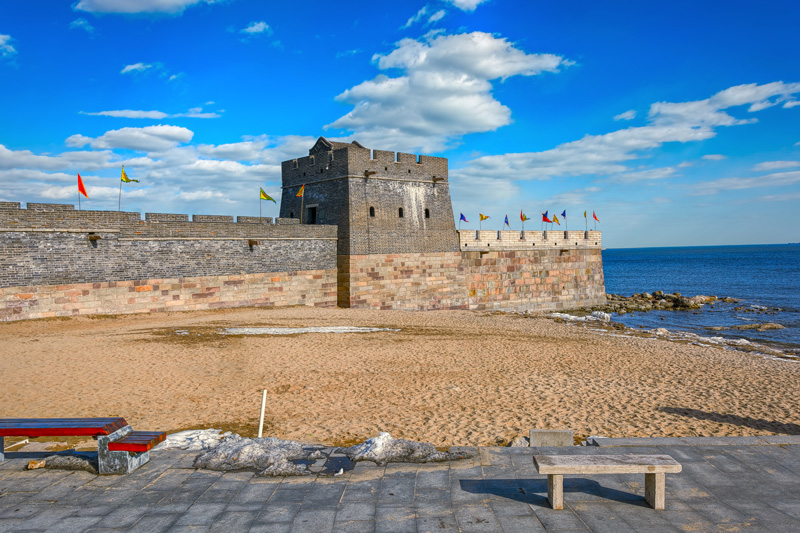
Legends and curiosities
This very important architectural work in China has always been at the center of numerous legends and even false myths . The first among these is that the Great Wall of China is visible from the Moon , but it was also confirmed by astronauts during the Apollo missions that this is not true ! In fact, this is probably one of the most widespread fake news ever, which some still doubt today. The rumor was spread in the mid -18th century by the English archaeologist William Stukeley . Another legend says that people, mainly slaves, who died during the construction of the Great Wall in China, were buried within the walls and Meng , a girl who discovered her husband’s body in the walls, threw herself into the sea in despair.
In Shanhaiguan , where the wall begins, there is the temple and the rock of Meng , where the woman waited for her husband before discovering the truth. The wall is also present in today’s culture, inspiring writers such as Franz Kafka , and directors for films set in China. Furthermore, it is present in video games and an inspiration for board games, such as Mah Jong .
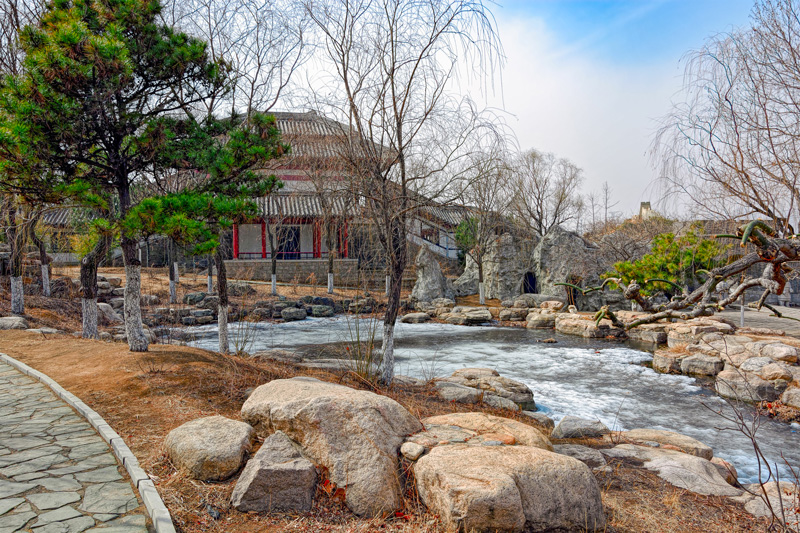
The Great Wall of China Visit, FAQ
How long is the Great Wall of China?
The length of the Great Wall of China is currently 21,196 km.
Where does the Great Wall of China end?
It ends at the sea, Shanhai Pass and Old Dragon Head.
Where is the Great Wall of China located?
It is mainly found in northern China, spanning the provinces of Gansu, Ningxia, Shaanxi, Shanxi, Inner Mongolia, Beijing, Tianjin, Hebei and Liaoning.
When was the Great Wall of China built?
Work on its construction began two thousand years ago, ending with the Ming dynasty.
How tall is the Great Wall of China?
The height of the Great Wall of China is on average 8 m.
Who built the wall?
The construction of the wall began with Qin Shi Huangdi, after he had unified China.
Where does the Great Wall of China begin?
Jiayuguan Pass is considered the beginning of the Great Wall of China.
How long did it take them to build the Great Wall of China?
The works under the Qin dynasty lasted over 20 years, then continuing under the Han dynasty for more than 200 years, until the Ming.
Read also: When to go to China? Climate and Period





